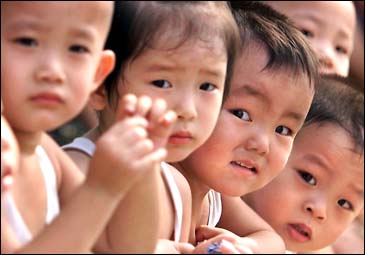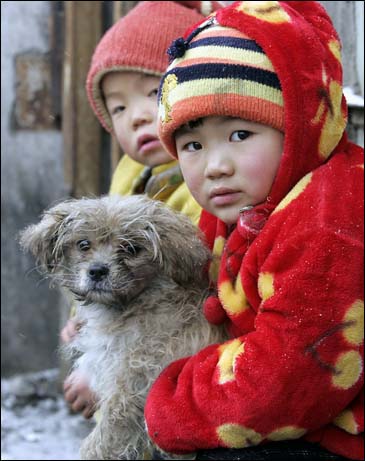Lost girls of China
![]()
Jasper Becker
![]()
Weekend: February 5-6, 2005
![]()

At the Jiaozuo Welfare Institute in the heart of the vast, impoverished rural province of Henan, staff are pasting up red ribbons and auspicious couplets so the children can celebrate Spring Festival.
Across the country some 75 million people will rush home to celebrate the holidays as 1.3 billion Chinese bid farewell to the Year of the Monkey. Many others are hurrying to get married ahead of the Lunar New Year because the coming Year of the Rooster is said to be unlucky for marriages and births.
A few couples will be thinking of adoption. Among the children at the
Jiaozuo Welfare Institute is a foundling who was taken in by police a year
ago. As usual, she is a girl. Wen Wen, as the staff named her, was just
three ½
You still can't talk openly in China about why so many girls like Wen Wen are abandoned and put up for adoption. It remains a sensitive topic, but everyone knows it is connected to the one-child policy put in place nearly 25 years ago. The subject may finally be coming out of the closet.
Chinese Communist Party leader Hu Jintao for the first time has asked the country's 300 leading demographers to examine whether the policy should be halted. Many of them are urging him to abandon it.
Chinese girls have borne the brunt of the one-child edict, a coercive effort to limit China's population to 1.2 billion by 2000. The target was missed but the policy caused a sharp drop in the number of births and a huge shortfall of girls.
The last national census, held in 2000, revealed that the policy may have been even more effective than thought. Now, questions are being raised about whether it should continue.
Experts disagree about how to interpret its findings but it looks like the population might be growing at a slower rate than was assumed. People are getting married much as before, but the population is growing at only 1.1 percent a year, or between eight and 10 million people.
The birth rate revealed by the census took demographers and government officials by surprise. It showed that the average fertility rate had dropped to 1.3 children per couple, far below the replacement level of 2.1. On those figures, China's population will stop growing and start declining by around 2040, several decades earlier than anyone had predicted.

The Chinese government decided the census results were wrong. The results did not correspond to data from school enrolment or other sources and the population growth figure was first adjusted upward to 1.6 percent and then to 1.8 percent.
``There is now a possibility that China's population might actually be less and not more than the official statistics say,'' says a senior Western demographer who declined to be named. Hitherto, experts assumed that parents in the countryside had been hiding 20 or 30 million children to escape penalties under the one-child system.
The possibility has provoked doubts about whether the tough policy is still really necessary. The populations of Shanghai and Beijing - minus the migrants - have actually seen negative population growth over the past decade as more urban couples choose not to have children.
China's success in bringing birth rates down close to those seen in developed countries also means that by 2050 at least a quarter of the population will be over 65.
Consequently, Chinese demographers are privately urging the party leadership to drop the policy altogether. They point out that many provinces already allow rural couples to have two children if the first is a girl. Urban couples should also be allowed to have more babies if they want to, demographers say privately.
``The new report is not out yet, but I think they are going to continue with the one-child policy. It is too difficult to stop it now,'' says a senior Western adviser to the Beijing government.
``Many fear that if they relax or drop the policy, then the population will rebound, as happened in 1983 and 1991, and people might all of a sudden start having a lot more babies.
``I think there will just be minor adjustments. They want to be careful.''
Another observer says: ``The data is still inconclusive. It is quite possible that the population might be less, but there's a chance it is higher. This makes it difficult to adjust policy.''
Both Chinese and Westerners fear discussing the issue openly because the census also reveals that the human rights abuses stemming from the one-child policy are as grave, if not worse, than feared.
The last national census shows that there are 20 percent more boys than girls below the age of five. In seven provinces, with a combined population of 387 million, there are between 28 percent and 36 percent more boys than girls in this age group.
``This is huge,'' says Professor Judith Banister, an American demographer who has pioneered many studies on China's population. ``This is the most extreme case on the planet, more extreme than India by a considerable margin.''
More and more girls disappeared from statistics from the early 1980s and the gender ratio widened in favor of boys every year, at least until 2000 when the situation seemed to stabilize, but at a high level.
Just how many girls are missing and what has become of them is still a matter of demographic guesswork, but it could mean an absence of 40 to 60 million girls by the end of the decade.
Banister notes that China's gender imbalance was even more extreme in the early half of the 20th century when the primary methods of getting rid of unwanted girls was infanticide or severe neglect after birth. The ratio became less distorted during the Mao Zedong era of the 1960s and 70s when the state encouraged people to have more children.
But when the one-child policy was extended to the countryside in 1980, the trend reversed again. In the mid-1980s, family planning units across the country were given ultrasound machines to enable authorities to inspect women suspected of illegally removing the obligatory state-provided means of contraception, the intra-uterine device or IUD. China is the only country in the world to do this.
The ultrasound devices enabled parents to see the sex of the fetus in the fourth or fifth month. If it was a girl, then they might opt for a late-term abortion.
A 2002 survey conducted in a central China village found that more than 300 of the 820 women had undergone abortions and more than a third of them admitted they had tried to select their baby's sex. The procedure is so cheap that there is little barrier to aborting an unwanted fetus. It can cost as little as 1,000 yuan (HK$943) for a backstreet abortion and just 30 yuan for an ultrasound.
There are about seven million abortions a year in China and a report by the International Planned Parenthood Federation says more than 70 percent of the aborted fetuses are female.
When the 2000 census showed a ratio of 117 boys per 100 girls below the age of five, compared to a normal range of about 103-107 boys per 100 girls, the alarm was finally raised, starting a debate about what should be done.
Most of the girls are missing because of late-term abortions, believes Banister, although demographic evidence suggests that many others may have been killed or died through neglect and mistreatment in infancy.
``A lot of people in China are determined to have a son. If they fail to get a boy, most would probably abandon the daughter rather than kill it. A lot of children are being abandoned,'' Banister says.
Just how many girls have been abandoned remains a secret. Until a few months ago, the Chinese government quashed all discussion of the issue inside China but now it has began to publish documents which at least refer to the problem.
The official orphanages are overwhelmingly full of girls, the only boys being those with severe handicaps. No one knows how many of the girls are adopted by parents inside China but the phenomenon is creating a growing exodus of abandoned Chinese girls.
Americans adopted about 5,000 Chinese girls every year during the 1990s, and 7,000 Chinese girls in 2003. Many European countries, especially those with very low birth rates, have been catching up. After the United States comes Spain, with a monthly average of 175 girls in 2003, followed by Canada which adopted an average of 77 a month last year.
While infanticide is hard to prove, demographic evidence shows that the death rate among girls up to age two is far higher than for boys. Demographic data also shows that the male infant mortality rate has fallen much faster than for female infants.
Recently, China announced that it intended to make selective abortion a criminal offence. It has set up a commission to draft changes to the criminal law although it is far from clear how this will work.
Earlier regulations and laws intended to outlaw infanticide, prenatal sex identification and sex-selective abortion have been easily flouted or poorly enforced. Corruption is so widespread that wealthy parents find it easy to bribe poorly paid doctors or low-ranking officials
``It is good the government is making it clear that it disapproves of these practises - many people in rural areas don't realize this,'' Banister says. ``If sex-selective abortion is criminalized, the focus of the law should be the medical personnel who are violating professional standards rather than pregnant women and ordinary couples whose attitudes still reflect China's traditional culture.''
India made it illegal in 1996 and threatened to jail doctors who broke the law, but there have been few successful prosecutions. Hainan Island - where in some schools boys outnumber girls by three to one - adopted a similar law last October with jail terms of up to five years, but there has not been a single arrest.
China is also taking other measures to entice people to keep baby girls, such as offering parents of girls a yearly pension of 800 yuan a year. Other programs exempt girls from school fees and grant housing, employment and welfare privileges to one-daughter families.
The new laws and penalties being drafted show that contrary to expectations, rising prosperity, urbanization and better education has not cured a deep-rooted cultural preference to have boys care for parents in old age and to inherit the land.
``Parents with one or more daughters but no sons are still most likely to abort or cause the death of a daughter,'' Banister says.
![]()
Copyright 2005,
The Standard, Sing Tao Newspaper Group and Global China Group. All rights
reserved. No content may be redistributed or republished, either electronically or in print, without express written consent of The
Standard.